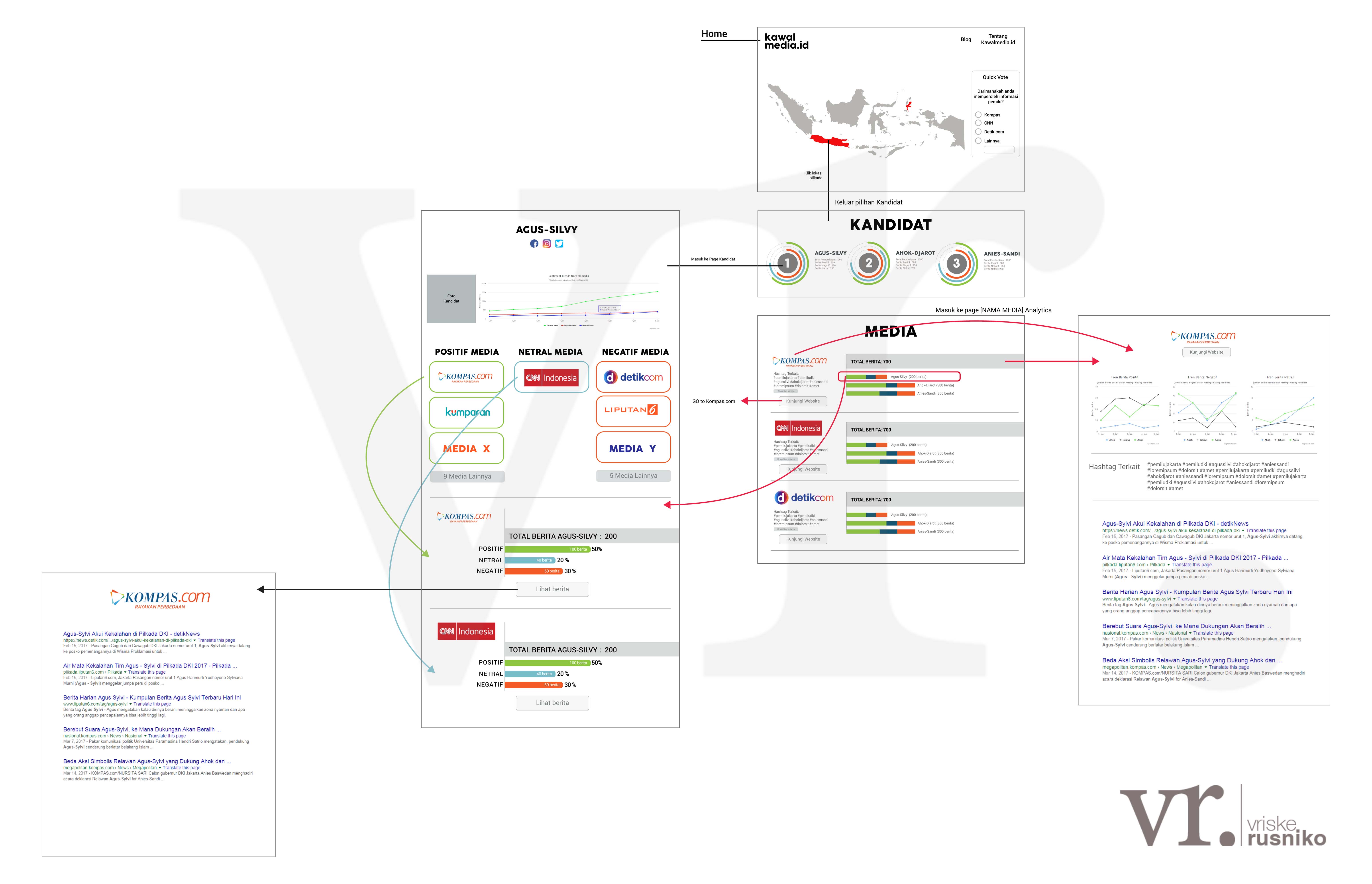Rojak Web Frontend is the users's GUI for kawalmedia.id (Coming Soon) built on top of React JS. This repository is also submodule repository of Rojak. Feel free to check the parent repository if you are interested to contribute in other kawalmedia.id components.
Rojak is a non-profit and open source project used for observing online news website in any election in Indonesia. It can be useful for doing some news data analytics in presidential, governor, or even major election. This project actually was initialized at the very first time at October 2016 here, to observe the 2017 governor election in DKI Jakarta. However, because there were some unfinished tasks on our first initiative, we weren't able to release this project to production. However, since the responses/contributions from the developer community was extremely good at that time, we have been thinking about restarting this initiative and coming up with new requirements for the incoming election in Indonesia.
In the long journey of an public election, our citizen usually get informations about the election candidate from the online news site. Unfortunately, some of the online media tend to take a side in one of the election candidates. This can create bias to some/most of the informations published on the site. It could give positive impact for a candidate they take the side with, or even bad impact to another candidate and vice versa. Unfortunately, it might give some impact to all/most of the citizen's sentiment about one or more candidates.
By developing this project, we really have a huge hope that we can increase the awareness of our citizens by providing them the analytical data about how news media creates stories and takes a side in an election. Besides, by contributing to this open source project, we hope that we will be able to stimulate more developers in Indonesia to contribute to open source software community.
Ultimately, we are going to call this project as kawalmedia.id. The usage of Rojak as the name of this project is to preserve the original initiative of this project.
For the first major release, this project will provide the following functionalities:
- The sentiment analytics about Pilkada Gubernur Jawa Barat and/or Pilkada Gubernur Jawa Timur.
- Sentiment analytics from all of the news created by some national or regional news websites related to those elections
Thanks to @vriskerusniko for creating this
wireframe:

- Install node, npm or yarn
- Install dependencies by running :
npm installoryarn install - Run application byL
npm startoryarn start
- All tasks related to frontend are documented in github issue and/or Frontend Trello board.
- Contributions are not limited to the tasks in Trello board. If you capture one or more bugs, feel free to create issue and then submit Pull Request to solve that issue.
- If you are interested in contributing in features development, feel free to take a task from Trello board and submit an issue in this repository. By default, you will not have access to edit the Trello board because you haven't been invited to Trello board. If that's the case, please create an issue and put description about which task that you want to work on. We will add you to the team member ASAP.
- Please go and check out Contributing Code of Conduct
The test environment utilizes Jest and Enzyme to test react components.
It is really helpful to write your tests before writing a component. This allows you to think out what the component needs to do before diving in!
Your first test should be pretty simple, testing that the component is rendering anything! For example for a component called Header a simple render test using enzyme would look like:
import React from 'react';
import { mount } from 'enzyme';
import chai from 'chai';
describe('Header', () => {
describe('rendering', () => {
it('should render something', () => {
chai.expect(mount(<Header />).html()).to.not.equal(null);
});
});
});After getting some output from your component you can incrementally add new structural features that your header needs, like an inner container to handle responsiveness. Testing any more structural parts of your component that isn't the root you can test them using the .find() and .exists() methods from enzyme.
import React from 'react';
import { mount } from 'enzyme';
import chai from 'chai';
describe('Header', () => {
describe('rendering', () => {
it('should render something', () => {
chai.expect(mount(<Header />).html()).to.not.equal(null);
});
it('should render an inner container', () => {
const wrapper = mount(<Header />);
chai.expect(wrapper.find('div.inner').exists()).to.be.true;
});
});
});Snapshots are a simple way to legacy test components you have written. They will notify you of any structural changes to your component and show you a neatly printed diff of the html including props. With jest writing snapshot test is simple!
import React from 'react';
import { mount } from 'enzyme';
import renderer from 'react-test-renderer';
import chai from 'chai';
describe('Header', () => {
describe('rendering', () => {
it('should render something', () => {
chai.expect(mount(<Header />).html()).to.not.equal(null);
});
it('should render an inner container', () => {
const wrapper = mount(<Header />);
chai.expect(wrapper.find('div.inner').exists()).to.be.true;
});
});
describe('snapshots', () => {
it('should match the snapshot', () => {
expect(renderer.create(<Header />).toJSON()).toMatchSnapshot();
});
});
});Running this test for the first time will generate the snapshot file. Every run after that will check the difference of the render to the snapshot file and if there are differences. If there are differences you want to keep you can run the tests again using the -u flag which re-writes the snapshot file.